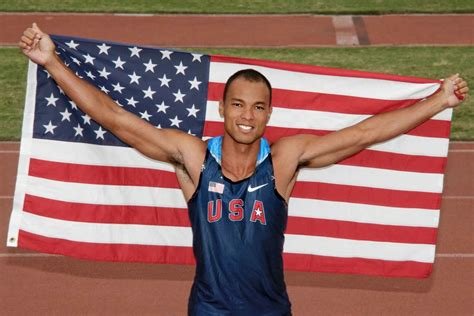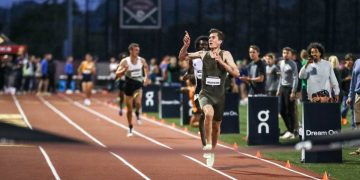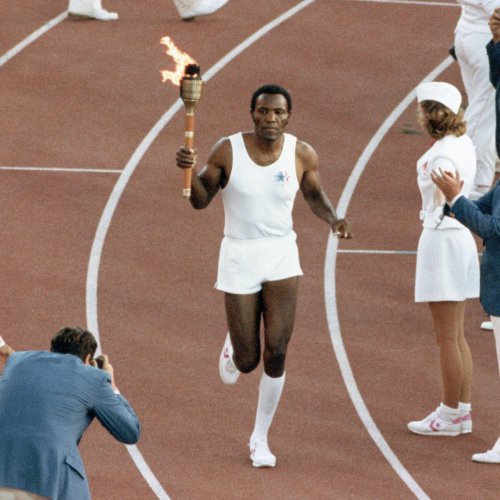 Rafer Johnson, taking the torch to LA 1984, photos: LA84 foundation
Rafer Johnson, taking the torch to LA 1984, photos: LA84 foundation
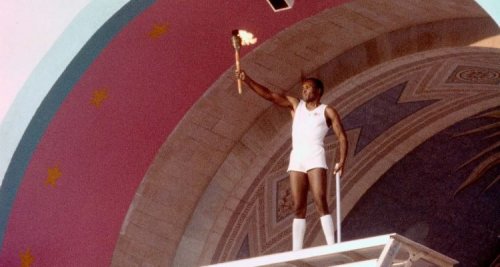 Rafer Johnson, taking the torch to LA 1984, photos: LA84 foundation
Rafer Johnson, taking the torch to LA 1984, photos: LA84 foundation
Updated 14 December 2020, added photos, corrected grammar, added coach’s name.
Rafer Johnson was the 1956 Olympic silver medalist in the decathlon, and the 1960 Olympic gold medalist in the decathlon, in one of the closest decathlons in Olympic history.
When Rafer Johnson died on 2 December 2020, he had lived a historic life. Rafer Johnson had lived a life that included American politics, Special Olympics, the Olympic movement and the iconic history of Americans in the decathlon.
Rafer Johnson was a role model. Rafer Johnson was a man of character.
Jeff Benjamin spoke with the living American decathlon gold medalists about how Rafer Johnson influenced them. This is the piece that you will see below:
“When Rafer Spoke, We Listened!”
America’s Decathlon Legends, Coaches and Historians Remember Rafer Johnson
By Jeff Benjamin“The World’s Greatest Athletes!”
It is one of the World’s most exclusive clubs, and this past week that club lost one of their paramount members.
Many people around the world mourned the passing of the Olympic legend Rafer Johnson, who passed away this past Wed at the age of 86.
Johnson, a 2-time Olympian and 1960 Gold medalist, left behind a legacy which went far beyond sports.
Here are some insights from those who not only knew him and his insights, but shared that common bond of dedication, focus and determination to pursue one of Sports’ greatest pinnacles – The Olympic Decathlon. As you will see, Rafer Johnson was an incredible presence, as evidenced by when he spoke.
Dr. Frank Zarnowski
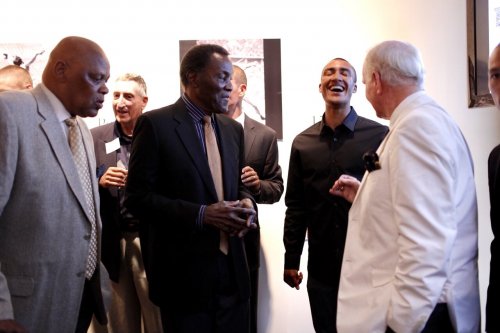 Milt Campbell (1952 silver, 1956 gold, Dr. Frank Zarnowski , Rafer Johnson, 1956 silver, 1960 gold, Ashton Eaton, 2012 gold, 2016 gold, photo by Ashton Eaton
Milt Campbell (1952 silver, 1956 gold, Dr. Frank Zarnowski , Rafer Johnson, 1956 silver, 1960 gold, Ashton Eaton, 2012 gold, 2016 gold, photo by Ashton Eaton
The preeminent Decathlon historian, Dr. Zarnowski had nothing but awe and praise for Johnson.
“When Rafer spoke, we listened,” said Zarnowski, an Olympic TV commentator and the author of many books on different Olympic subjects throughout the decades.
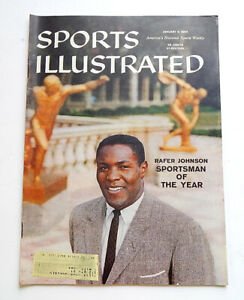 Rafer Johnson, Sport Illustrated cover
Rafer Johnson, Sport Illustrated cover“He was a quiet, humble man who never raised his voice…He had a degree of regal about him and he had better posture – straight and rigid – that I’ve never seen from anyone else in my life… I don’t know where that came from.”
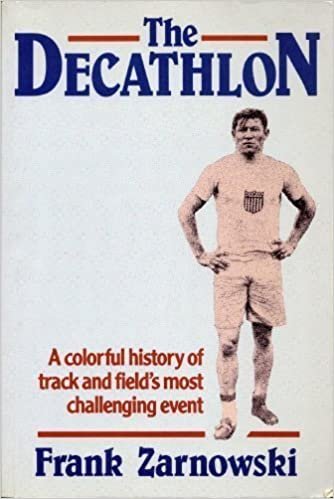 The classic book on the decathlon, by “Zeke”, aka Dr. Frank Zarnowski
The classic book on the decathlon, by “Zeke”, aka Dr. Frank Zarnowski“Rafer also overcame more in society growing up than all the Champions except Jim Thorpe,” said Dr. Zarnowski.
“He grew up in poverty in a box car and rose from that to greatness.”
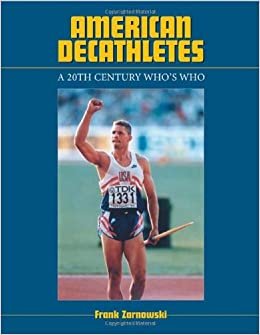 This book is about American Decathletes, by Dr. Frank Zarnowski, the dean of Decathlon knowledge
This book is about American Decathletes, by Dr. Frank Zarnowski, the dean of Decathlon knowledge“It’s a big loss.”
Decathlon Coach Harry Marra
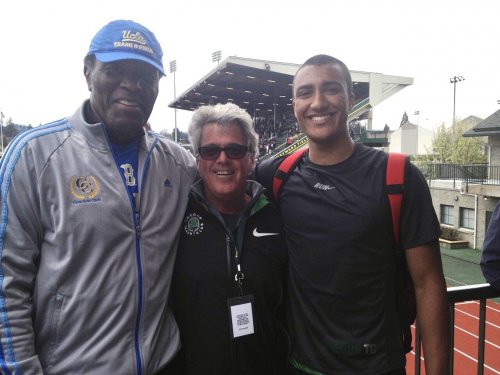 Rafer Johnson, Harry Marra, Ashton Eaton, photo by Ashton Eaton
Rafer Johnson, Harry Marra, Ashton Eaton, photo by Ashton Eaton Like Zarnowski, Coach Marra is a proud Decathlon “Lifer”, as well he should be. Harry Marra coached Ashton Eaton, among other elite decathletes.
Marra has produced nearly all of America’s Decathlete stars going back to the 1980’s, and was the American National Decathlon Coach from 1990-2000.
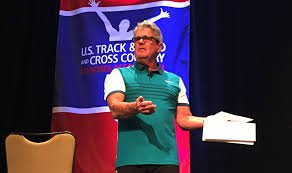 Coach Harry Marra, photo by USTFCCCA
Coach Harry Marra, photo by USTFCCCA
“Rafer Johnson was an integral part of the Decathlon in historical perspective not only in America, but throughout the world,” said Marra, who still possess that driving passion for the event he loves. “He did so much more for so many people, but especially with the Kennedy family when he got involved in the Special Olympics.”
“When VISA set up our Olympic Decathlon sponsorship program back then in 1990, Rafer made sure to attend EVERY meeting and talk with the athletes…kids and athletes looked up to him!”
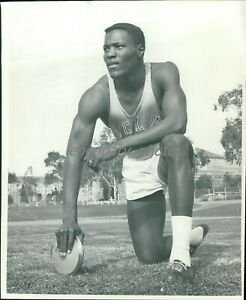 Rafer Johnson, photo by UCLA sports
Rafer Johnson, photo by UCLA sports
“Back in 2010, we had at Oregon a dual meet with UCLA and came to the meet…I asked Rafer if he could spend some time and talk with one of my athletes and he spent 45 minutes with him on the 2nd floor of the Bowerman building…my athlete left there with the belief that he could be like Rafer Johnson – that athlete was Ashton Eaton!”
“Rafer was a Saint.”
Ashton Eaton
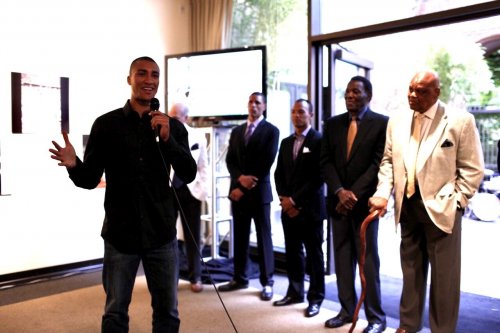 Ashton Eaton, Dan O’Brien (1996 gold), Bryan Clay (2004 silver, 2008 gold), Rafer Johnson, 1956 silver, 1960 gold, Milt Campbell, 1952 silver, 1956 gold, photo by Ashton Eaton
Ashton Eaton, Dan O’Brien (1996 gold), Bryan Clay (2004 silver, 2008 gold), Rafer Johnson, 1956 silver, 1960 gold, Milt Campbell, 1952 silver, 1956 gold, photo by Ashton Eaton
The 2012 and 2016 Olympic Decathlon Gold Medalist, Eaton reinforced Coach Marra’s praise of Johnson.
“Rafer was a bastion of the Sport and someone I aspired to be like both athletically and in character. Everyone who knew him only had good things to say about him. And you never heard Rafer talk about himself. He was a man who had a storied life who used his action to speak more than his words. But, when he did speak you couldn’t help but listen. Seems to me that outside of Sport he spent his time on earth in service of others.
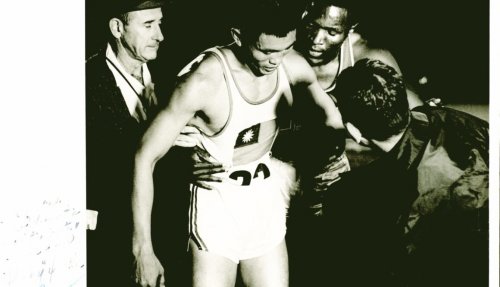 1960 Olympics, CK Yang, Rafer Johnson, post 1,500m in Decathlon, photo by UCLA sports / LA 84 foundation
1960 Olympics, CK Yang, Rafer Johnson, post 1,500m in Decathlon, photo by UCLA sports / LA 84 foundation I also met him in 2012 various times. We did spend time together with other decathletes, new and old, at Hayward field after I broke the world record. In one of the images attached, you can see Rafer mid speech and all heads toward him.
Overall, I find it an honor to have been alive when he was and to have participated in the same discipline in sport.”
Bryan Clay
Bryan Clay, photo by USOC
Bryan Clay was coached by Kevin Reid , Clay won Olympic Decathlon Gold in 2008 Beijing and silver medal in 2004 in Athens, emulating Rafer Johnson’s two Olympic medals.(Bob Mathias won Olympic gold in 1948 and 1952, Milt Campbell won silver in 1952 and gold in 1956, and Rafer won silver in 1956 and gold in 1960).
“I didn’t get to hang out with Rafer like others did,” said Clay. “I met him a few times but I think his importance and what made him a legend was also his involvement off the track, especially with Special Olympics…that showed who he was, his character showing the importance of giving back and we should all do it…Rafer Johnson was just an admirable, great human being.”
Dan O’Brien
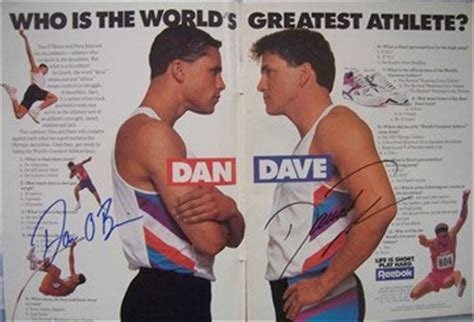 Dan and Dave ads, circa 1992, ads courtesy of Reebok (the best ad campaign in athletics )
Dan and Dave ads, circa 1992, ads courtesy of Reebok (the best ad campaign in athletics )The 1996 Olympic Champion, O’Brien was one of those young driven athletes in the VISA program, and met all of the legends, including Johnson.
“When Rafer Johnson won the Gold in 1960, a new constellation star appeared in the sky,” said O’Brien, who nowadays coaches and has done TV/Radio Commentary for major networks.
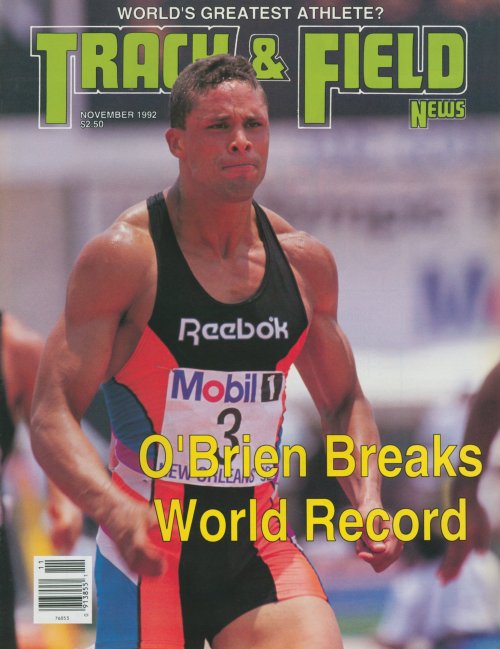 Dan O’Brien on TFN cover
Dan O’Brien on TFN cover“He truly set a standard that we all tried to follow.”
“At the old VISA camps during the 1990’s we saw Rafer year after year and we as young athletes were in awe and looked up to him as well as the other Champions…it was interesting to learn about the different types of training in the different eras.”
“But when Rafer spoke, we listened!”
“In 2012 I got to spend with Rafer in Eugene at the Olympic Trials,” said O’Brien. “At the Trials all of the Decathlon Gold Medalists got to do a salute victory lap in Hayward Field abd I had realized I had never done a victory lap, so it was special for all of us, including Rafer.”
O’Brien may be the only legend to have seen an emotion of angst from Johnson, although it was in good fun.
“I got to know the 1956 Champion Milt Campbell and we and our wives spent time together,” recalls O’Brien.
“Rafer had been favored to win in 1956-he’d later win in 1960- by Milt treated him as that kind of little brother…In front of Rafer Milt would goad and ask us which one was better…”Cmon, who was better?”, he’d say. Then he’d get in us to ask Rafer, who was silent….Rafer eventually tightened up and said,
“Please Don’t Ask Us”!
“That was about as aggressive as he got!”
O’Brien then concluded with a final story.
“Through the years Rafer, myself and other stars would attend the summer Hershey Youth Games in Pennsylvania,” said O’Brien.
“One of the things we had to do was attend this dinner with all the sponsors and the big suits…So we had to dress up…Carl Lewis, Gail Devers and others came with us and when we got to the dinner, Rafer didn’t show…So I asked someone where he was, and someone told me that Rafer had bought a whole bunch of Pizza Pies and was eating with the kid athletes in their dorm rooms!”
“Rafer was so respected and set a standard not only in the Decathlon but in Life which we all looked up to.”
“He transcended the Sport”
Bill Toomey
 Bill Toomey, photo by baan-atletiek.nl
Bill Toomey, photo by baan-atletiek.nl82 Years Young, “And I’m still in Great Shape!” The 1968 Olympic Champion reminisced about the athlete who became his friend.
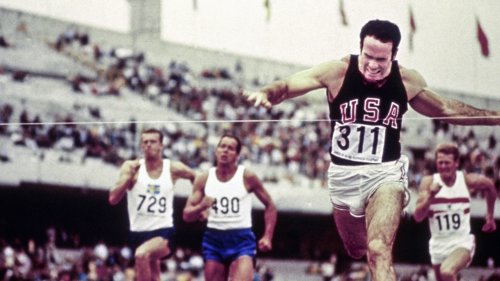 Bill Toomey, photo by USOC
Bill Toomey, photo by USOC “Rafer had a great spirit of acceptance about him,” recounts Toomey, who went on to work at the highest levels of the Sport in both the U.S. and International Olympic Committees.
“You realized the stature of greatness he had and my impression is that I don’t know of any Olympic Athlete who had the charisma, generosity of Spirit and respect…he was always the Center in the room!”
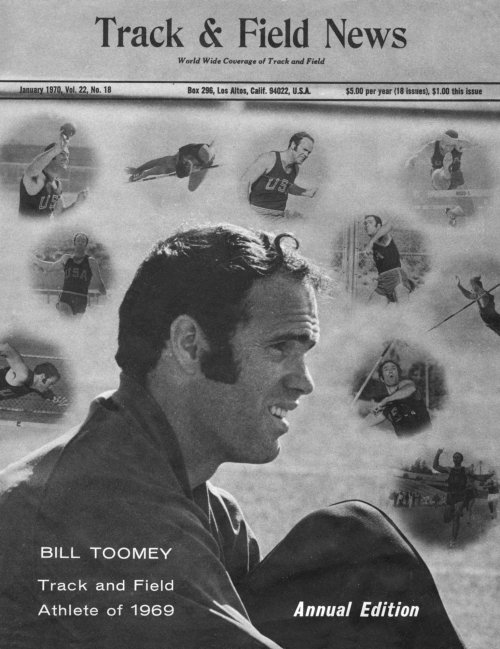
Bill Toomey,
TFN cover,
TFN Athlete of Year
Toomey also got to know Rafer in a physical sense, though perhaps not the way he wished.
“We once visited the Kennedy’s up in Hyannis Port and played tennis with Eunice and Ethel,” recalled Toomey fondly.
But it was about to get more challenging.
“We did this film before the 1972 Munich Olympics called “Ancient Games”…it was a re-enactment of Rafer and I competing in the Ancient Greeks Olympic Pentathlon in Athens with the 190 meter staid track from Ancient times….We sprinted, ran, jumped and threw….but then we had to finish with wrestling!…When we began Rafer gave me a forearm shiver and I knew he was serious!”
“If you really want to know a guy, then wrestle him!”
Who won?? – Check out the YouTube link to “Ancient Games”
Toomey then reflected seriously. “He was just a great, great human being and I will eternally look up to him.”
“If you were a father and had a son who’d you want him to be?”
“I’d say “Rafer Johnson!”
Caitlyn Jenner
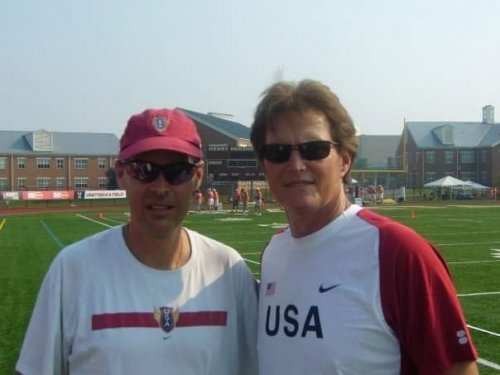 Jeff Benjamin and Bruce Jenner, photo by Jeff Benjamin
Jeff Benjamin and Bruce Jenner, photo by Jeff Benjamin
In 2020, a generation of fans do not recognize the drive, desire and inspiration Caitlyn Jenner possesses are qualities which go all the way back to another time, when then-Bruce Jenner followed the dream to become the Greatest Athlete In The World.
“When I got started in the Decathlon I had only done 5 of the individual events,” said Jenner recently. “I competed at the Drake Relays in 1970 and had reasonable success.”
Even then, Jenner looked at history and a person’s place in it. “Not only did I love the variety of 10 different events, but I saw that the title – “The World’s Greatest Athlete” – was it…It is the ultimate test of running, jumping and throwing.”
Jenner then began looking at the history of the event.
“Back then I just wanted to do my best and be inspired…The Champions of the Past – Jim Thorpe, Bob Mathias, Milt Campbell, Rafer Johnson, Bill Toomey – didn’t just become Champions but also part of history, and that drove me.”
Many are not aware that Jenner competed for the United States at a the 1972 Munich Olympics, finishing 10th. “Being in those Olympics prepared me for 1976 mentally,” said Jenner, who had no choice but, like all other Olympic hopefuls, to live in the world of the Amateur Athlete. “As I got better by 1976, I was actually living on about $10,000 a year with $145 a month rent and living on nothing.”
What kept him going through this adversity?
“I wanted to be on the same Gold medal stage with those guys before me!”
As everyone knows, Jenner’s legendary Montreal 1976 performance led to the Gold medal and that dream of sharing the stage.
“After the Olympics there was a sponsored event where all of the Champions were with me and I got to go up on the stage with them….It meant so much to me to be a part of the history.”
It seems, according to Jenner, that Rafer Johnson may have been the most inspirational.
“Looking back, Rafer had a big impact on me as an athlete and a human being,” said Jenner.
“We became good friends even though we didn’t see a lot of each other, and we all know that friend we care about but don’t talk for a few years but then you can pick up where you left off, and Rafer was one of those people.”
Jenner then recalled a real tense but funny story around the Opening Ceremonies of the 1984 LA Olympics!
“The greatest secret was who would light the Olympic Torch…Two weeks before the Games I’m in an empty LA Coliseum with Peter Ueberroth and Games Producer David Wolper asked if he could speak with me….so he tells me he has an issue and needs my help…Wolper says, “We have a guy who’s going to light the torch but he’s got a hamstring problem”…he then asks me if I could do it and I’m like, “Yeah Baby I’m There!”…The Wednesday before the ceremony I go to the Coliseum as directed and there’s Rafer jogging on the track….we jog stretch and talk…I say to him “So Rafer you’re lighting the torch?” And he says, “No,No,No”….I then said, “I know I’m the alternate so come on it’s just you and me Rafer – You’re the Guy!”
Johnson finally humbly admitted to Jenner he was the Torch-Bearer.
“But Rafer says to me that his hamstring is killing him and he wasn’t sure he could run the 400 meters around the track abs then go up the 99 steps to the top to light it,” said Jenner, noting that the platform at the top was a bit shaky to say the least.
After some practicing by the 2 Legends, Ueberroth, Wolper, Jenner and Johnson agreed to set up a relay in the stadium of others and then Rafer would run less than the lap to then go up the 99 steps where a ground pole he could hold on to with one hand would keep his balance as he lit the torch with the other hand.
Jenner would be one of the honorary carriers of the Olympic Flag. All seemed well.
But Wolper wanted insurance.
“Wolper called me 3 days before the Ceremonies again,” recalled Jenner.
“He told me to come down to the stadium to get a running uniform which I would wear under my white suit and after I bring the flag in to stay by the 99 steps and if Rafer falters, I’m to grab the torch and run up to light it!”
On the day of the opening ceremonies as Jenner went into the room prior to carrying the flag, flag co-honorees John Naber and Al Oerter asked him why he had a running suit on under the white suit?
“I told them to story that if Rafer goes down I have to take the torch up…well Naber goes, “No,no,no – “If I’m the first one to get the torch I bring it up” and Oerter says, “Wrong!..The last one to have it gets to light the torch and that’s me!”
Now Jenner had to deal with a potential conflict to say the least.
“I’m now thinking we’d all have to fight for that torch!”
But Jenner had faith.
 Rafer Johnson, taking the torch to LA 1984, photos: LA84 foundation
Rafer Johnson, taking the torch to LA 1984, photos: LA84 foundationAfter bringing the Olympic Flag into the stadium, 90,000 spectators and billions of television viewers saw Rafer Johnson begin to carry the torch.
“Naber, Oerter abs I were sitting on the bench by the steps,” recalled Jenner.
“I was going to get the white suit off but I made the decision at that moment that I’d have confidence in Rafer….I never took my white suit off.”
“Rafer came through and he did great!”
Rafer Johnson, taking the torch to LA 1984, photos: LA84 foundation
“He has been such a class act – a Humanitarian Champion – always soft-spoken.”
Echoing the others before him, Jenner concluded –
“I always listened to him.”
Jeff Benjamin has written for 30 years for American Track and Field along with RunBlogRun. The Former President of the Staten Island AC & Chair of the Staten Island Running Association was the 5th man scorer for his Susan Wagner High School NYC XC City Championship team. Also a member of the College of Staten Island Sports Hall of Fame for XC, Jeff currently serves as the LDR Chairman for USATF NY. A passionate (or fanatical) follower of the Sport, some of Jeff's subjects have included Sebastian Coe, Emma Coburn, Eamonn Coghlan, Matt Centrowitz, Jim Spivey, Galen Rupp, Joe Newton, Tom Fleming, Ajee’ Wilson, Bill Rodgers, Allan Webb, Abel Kiviat, Jordan Hassay, Marty Liquori, Caster Semenya, Rod Dixon, Carl Lewis and Jim Ryun as well as Book Reviews and articles covering meets and races in the Northeast U.S.
View all posts
 Rafer Johnson, taking the torch to LA 1984, photos: LA84 foundation
Rafer Johnson, taking the torch to LA 1984, photos: LA84 foundation Rafer Johnson, taking the torch to LA 1984, photos: LA84 foundation
Rafer Johnson, taking the torch to LA 1984, photos: LA84 foundation Milt Campbell (1952 silver, 1956 gold, Dr. Frank Zarnowski , Rafer Johnson, 1956 silver, 1960 gold, Ashton Eaton, 2012 gold, 2016 gold, photo by Ashton Eaton
Milt Campbell (1952 silver, 1956 gold, Dr. Frank Zarnowski , Rafer Johnson, 1956 silver, 1960 gold, Ashton Eaton, 2012 gold, 2016 gold, photo by Ashton Eaton  Ashton Eaton, Dan O’Brien (1996 gold), Bryan Clay (2004 silver, 2008 gold), Rafer Johnson, 1956 silver, 1960 gold, Milt Campbell, 1952 silver, 1956 gold, photo by Ashton Eaton
Ashton Eaton, Dan O’Brien (1996 gold), Bryan Clay (2004 silver, 2008 gold), Rafer Johnson, 1956 silver, 1960 gold, Milt Campbell, 1952 silver, 1956 gold, photo by Ashton Eaton  1960 Olympics, CK Yang, Rafer Johnson, post 1,500m in Decathlon, photo by UCLA sports / LA 84 foundation
1960 Olympics, CK Yang, Rafer Johnson, post 1,500m in Decathlon, photo by UCLA sports / LA 84 foundation  Bill Toomey, photo by baan-atletiek.nl
Bill Toomey, photo by baan-atletiek.nl







